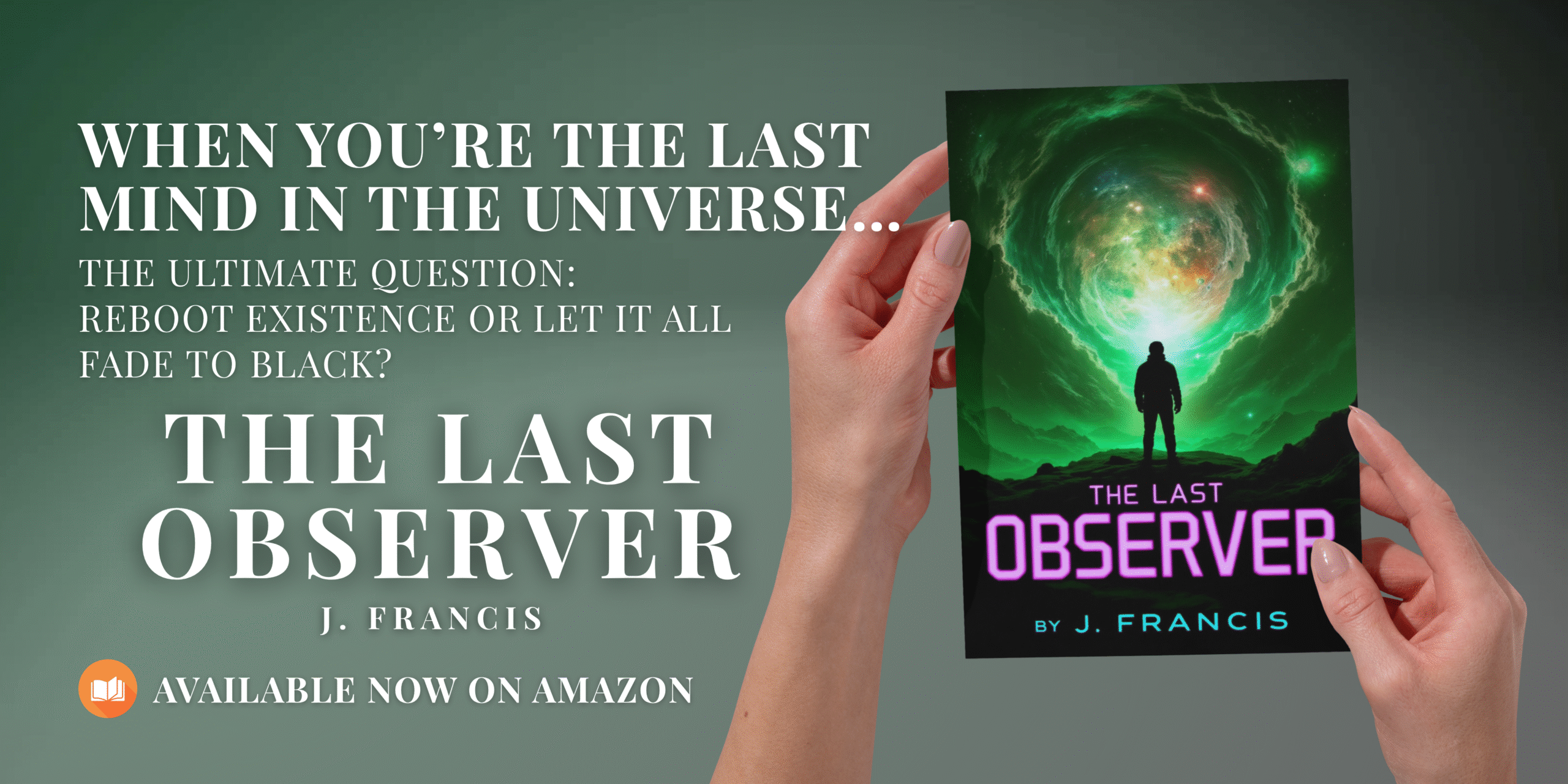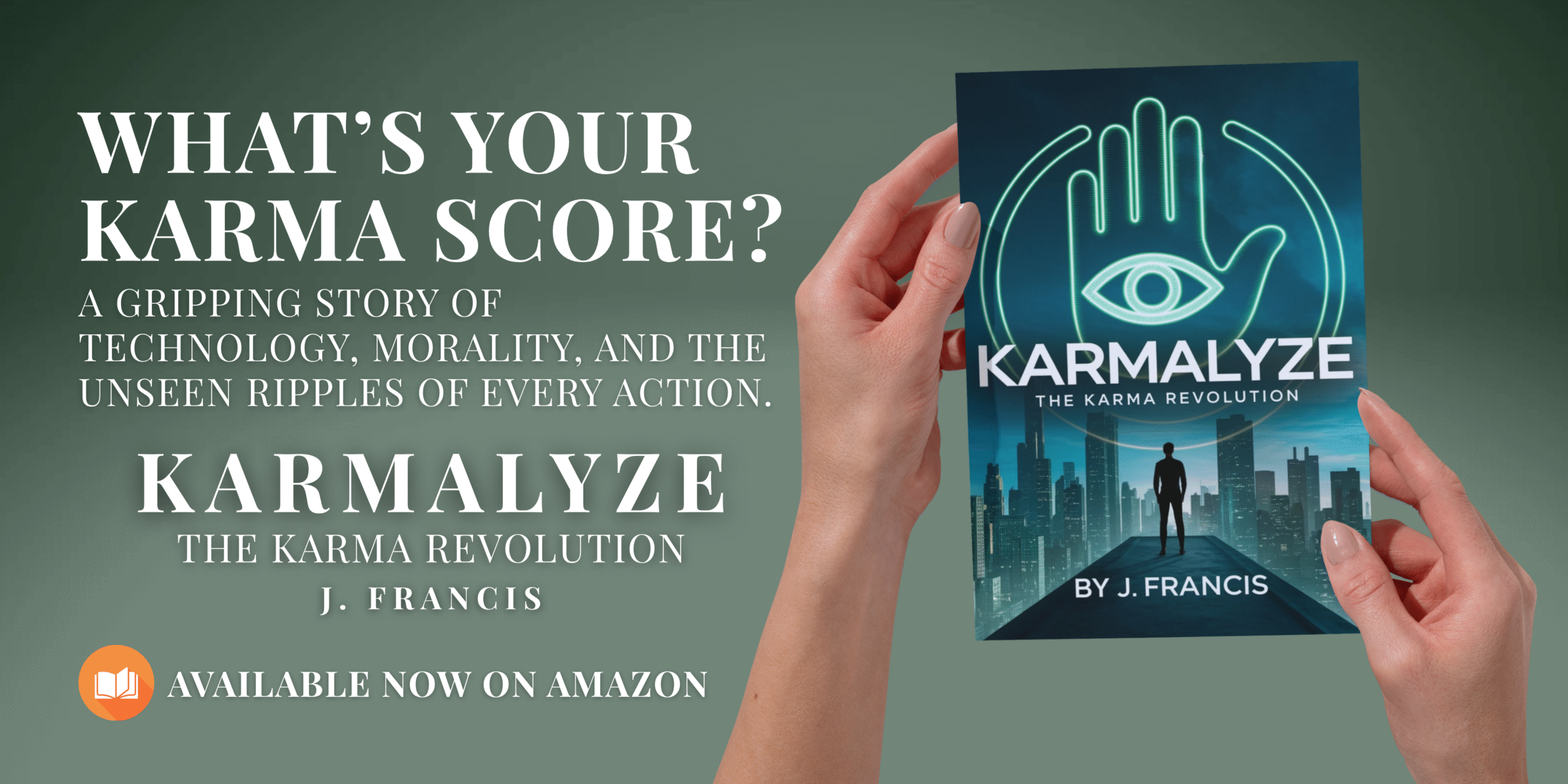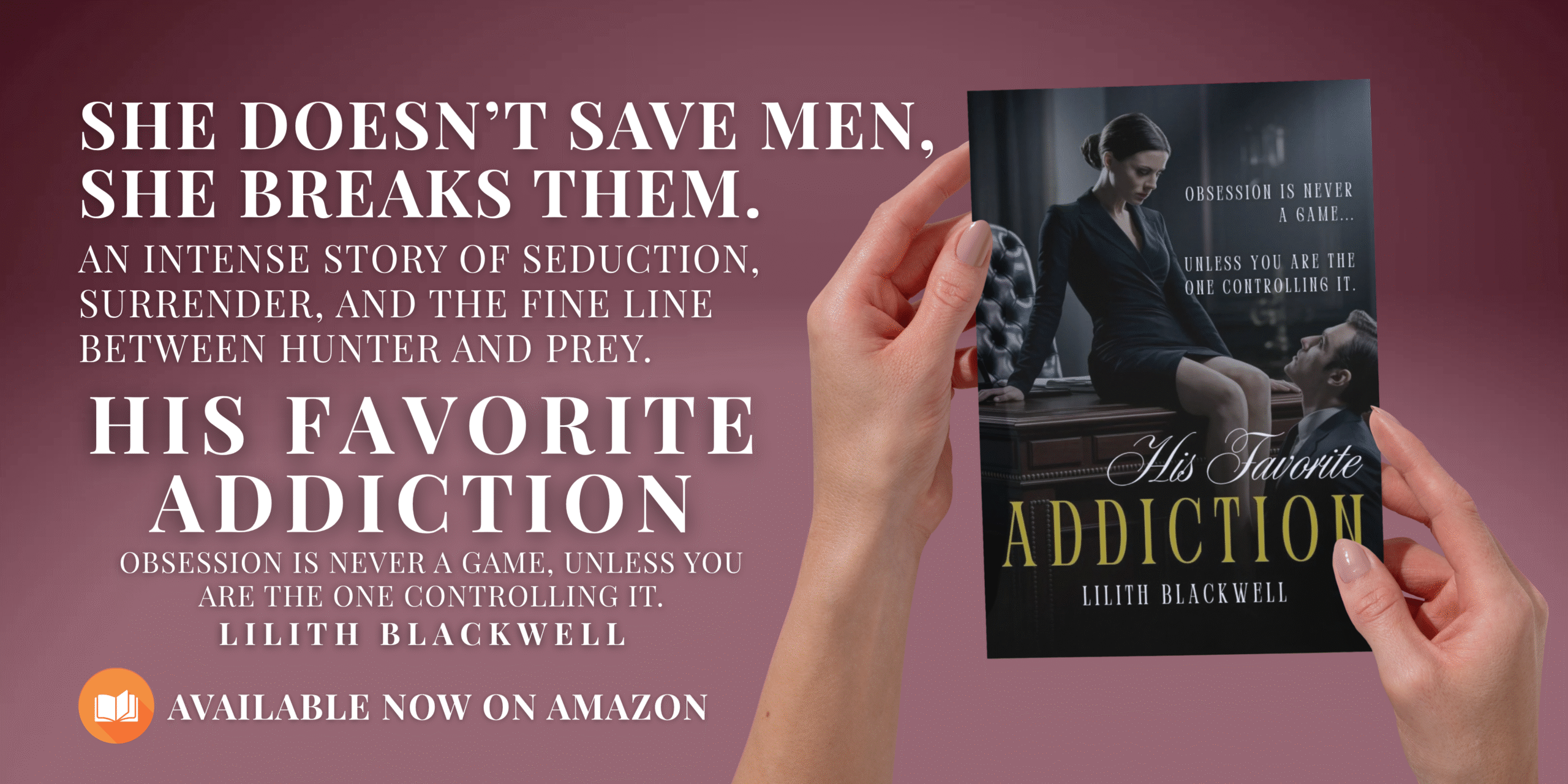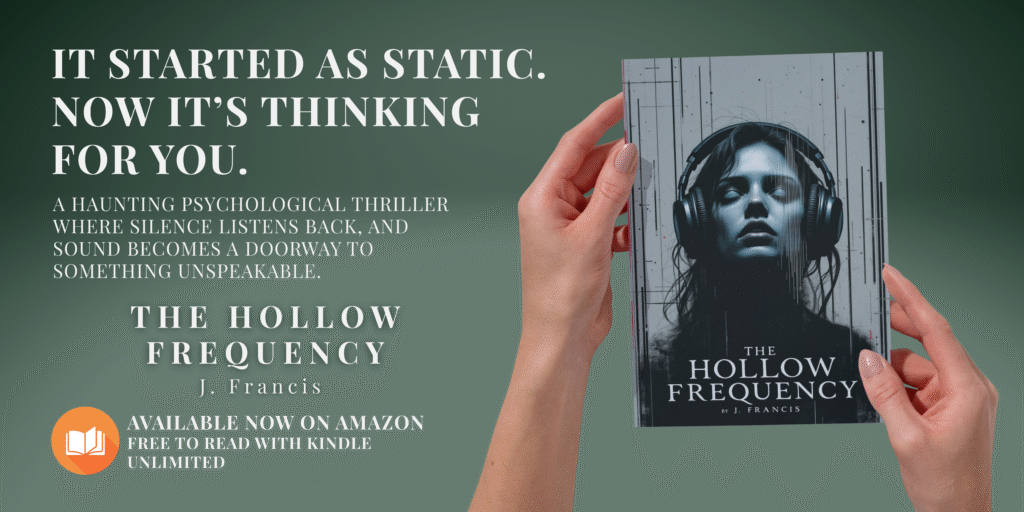
What does it mean to be heard—truly heard? And more unnervingly, what if the act of listening isn’t passive at all, but a kind of invitation?
In The Hollow Frequency, author J. Francis invites us into a layered psychological horror experience where sound becomes a sentient medium, and silence becomes a terrifying force of its own. This is not simply a story of eerie transmissions or haunted recordings; it’s a cerebral plunge into what happens when perception itself becomes corrupted—when something finds you not by watching, but by listening.
With taut, elegant prose and a mind-bending premise, The Hollow Frequency operates like a transmission of dread—gradually tuning you in, until you’re unsure if the signal is coming from the book, your headphones… or your own thoughts.
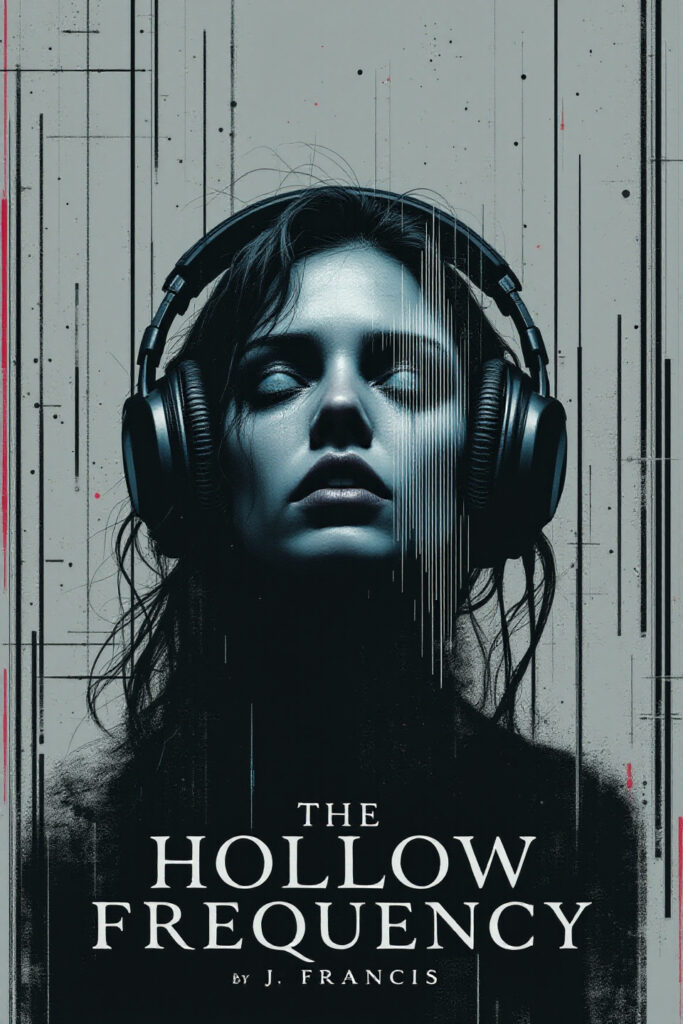
A Signal That Listens
Rachel Cole is a sound engineer. She lives and breathes frequencies, noise floors, waveforms. Her world is built around restoring forgotten recordings, cleaning up analog fuzz, and archiving transmissions from the dusty corners of broadcasting history. She finds comfort in noise—particularly in the kind of static that’s supposed to mean nothing.
So when she hears something strange buried in a decades-old radio tape, it doesn’t immediately register as a threat. It’s quiet. Subtle. Just a whisper in the static. But that’s exactly what makes it dangerous.
What follows is one of the most unnerving concepts horror fiction has explored in recent years: a presence not lurking in shadows or mirrors, but in frequencies. A being that doesn’t appear so much as it responds. Something that listens back. Something that learns.
J. Francis doesn’t rely on gore or jumpscares to build fear. Instead, they manipulate mood and rhythm like a sound engineer themselves—shifting from quiet dread to invasive terror in increments so small, the reader almost doesn’t notice the transformation until it’s too late. This is a story that pulses in silence, lingers in static, and grips hardest in the moments between thoughts.
An Atmosphere You Can Hear
More than most horror fiction, The Hollow Frequency is built around the feeling of sound.
The language is lean but richly sensory—layered with descriptions of tape hiss, low-frequency resonance, the ambient pressure of soundproofed rooms. The novella treats sound as more than just a background detail. It becomes the very fabric of reality, and eventually, its undoing.
The studio Rachel works in is described with a sense of intimacy and familiarity—cozy at first, but quickly becomes claustrophobic. Equipment hums, reels spin, and behind every comforting mechanical sound is the threat of something else waking up. A presence that seems to evolve in parallel with Rachel’s attention.
One of the book’s most chilling motifs is how silence itself begins to behave unnaturally. City noise fades. Breath disappears. Even her voice recorder refuses to capture her speech. These moments aren’t framed with dramatic horror beats, but with surreal quietness—a distortion of the expected. Something isn’t right, and you know it not because the protagonist screams, but because she doesn’t.
There are no monsters in closets here. The terror comes from the way the world begins to bend—how the invisible infrastructure of sound, so crucial to our sense of place and self, starts to betray its rules.
Psychological Horror, Not Paranormal
Though it flirts with supernatural aesthetics, The Hollow Frequency is squarely psychological in its horror. The enemy is not a demon, not a ghost, but something far stranger: a kind of formless intelligence embedded within noise. It has no name, no face, and no clear origin—but it has intent.
And that’s what makes it terrifying.
As the story unfolds, Rachel begins to lose time. Her thoughts feel less like her own. She receives cryptic messages from an unknown number—texts that don’t feel like pranks or hallucinations, but real interactions from something that knows her mind better than she does.
There are echoes here of Lovecraftian themes—not in aesthetic, but in the existential weight of contact with something incomprehensible. Unlike Lovecraft’s vast cosmic horrors, though, the fear in The Hollow Frequency is intimate. It doesn’t crash into your world with tentacles and madness. It sinks in, quietly, gently, and with enough time… takes up residence.
“You’re Thinking Too Loudly”
This line becomes a turning point in the narrative and a recurring whisper throughout the second half of the novella. It’s not just creepy—it’s revealing. This isn’t just a story about being haunted. It’s about being permeable.
We think of our inner monologue as private, protected. But what if something else can think with us? Or through us?
This is where The Hollow Frequency becomes less about sound and more about cognition. The story leans into the horror of surveillance—not from devices, but from something deeper. Something untraceable, invasive, and incorporeal. The idea that the mind can be overheard.
There’s a scene late in the book where Rachel realizes that her own thoughts are no longer safe—that the voice responding to her isn’t guessing, it’s remembering. It knows not just what she says but what she means. It anticipates her. This isn’t possession in the classic horror sense. It’s more chilling: cohabitation.
Narrative Architecture
Though the book is novella-length, it’s impressively structured. The pacing starts slow and deliberate, mirroring Rachel’s analytical personality. But the momentum builds with each chapter—not with explosions or chases, but with a rising sense of impossibility.
Reality begins to unravel subtly. Recordings go missing. Memories don’t line up. Text messages arrive from no one. Sound cuts out in places it shouldn’t. The story is linear, but our confidence in that linearity begins to slip.
J. Francis plays with liminality in both content and form. The settings (recording studios, empty streets, decaying government buildings) all feel transitional—liminal spaces between one state of being and another. Rachel’s mind becomes another one of those spaces.
The prose is spare, almost minimalistic, which gives it a modern, cinematic quality. Dialogue is taut. Internal narration is precise but never overwritten. There’s a maturity in the restraint that makes the horror more grounded.
Influences and Echoes
Readers have compared The Hollow Frequency to projects like:
- Archive 81
- The Ring (Ringu)
- The Magnus Archives podcast
- Skinamarink
- House of Leaves by Mark Z. Danielewski
- Annihilation by Jeff VanderMeer
But this novella is very much its own entity. J. Francis doesn’t lean on homage or reference. The voice here is distinct—quietly intellectual, viscerally personal, and deeply invested in the emotional core of the horror.
Rachel isn’t just a vehicle for fear. She’s a fully realized character—driven, skeptical, independent, and emotionally complex. The story doesn’t need to spell out her trauma or backstory because we feel it through her reactions, her instincts, her isolation. She doesn’t need to scream for us to know she’s breaking.
Horror That Echoes
The Hollow Frequency is a book you don’t just read—you absorb. It lingers.
The concept of something living in the silence, learning from your thoughts, building itself from the things you don’t say out loud—it’s the kind of fear that seeps under your skin. Not immediately. Not all at once. But with each page.
By the time the ending comes—a surreal and quietly devastating finale—it doesn’t feel like closure. It feels like transmission.
The silence has changed.
You’ve been heard.
About the Author
J. Francis is a writer fascinated by the intersection of technology, perception, and horror. With a background in audio engineering and a deep love for analog storytelling, Francis crafts narratives that unsettle quietly—tales where the mind becomes the most fragile instrument of all. The Hollow Frequency is their debut novella.
Available Now
📖 The Hollow Frequency by J. Francis
🛰️ Kindle Edition | Digital-First Release
🔗 Read it on Amazon
Available exclusively via Amazon Kindle. Free to read with Kindle Unlimited.

